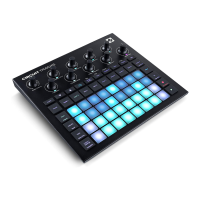46 47
You can change the Gate value by pressing the pad in the Gate value display that corresponds to
the Gate value; that is, the number of pattern steps that the note at the step should sound for. If you
wanted the note at Step 1 in the example above to sound for four steps instead of two, you would
press pad 4; Pads 1 to 4 then illuminate sand (off white). You can either lengthen or shorten the note
in this way.
Fractional Gate values are assigned by pressing the highest-numbered illuminated pad in the Gate
value display an additional number of times: this will always shorten the Gate time. Each additional
press reduces the Gate time by one sixth of a step, and the illumination dims incrementally at each press.
Thus if a Gate duration of 3.5 was required for Step 1, the example above would look like this:
9 10 11 12 13 14 15 16
1 2 3 4 5 6 7 8
Step whose Gate
value is displayed
Pad 4 is dimly lit indicating
Gate value is now
between 3 and 4
Pattern step display
Gate value display
After the fifth press on the pad, the Gate time reverts to the former integral value on the sixth, and
the pad resumes its original full brightness.
You can also use Gate View to change Gate values while a pattern is playing. In this case, you need to
press and hold the pad for the step to have its Gate value changed; you can do this at any point in the
pattern. The held step pad will illuminate red, and the Gate value display will “freeze” to display the Gate
value of the selected step. Press the pad corresponding to the new value required. The pattern continues
to play, so you can experiment with different Gate values in real time.
Pattern steps with no notes have a zero Gate value; all Gate pads in Gate View for such steps will be
unlit. You can’t edit a step’s Gate Value if there are no notes assigned to that step.

